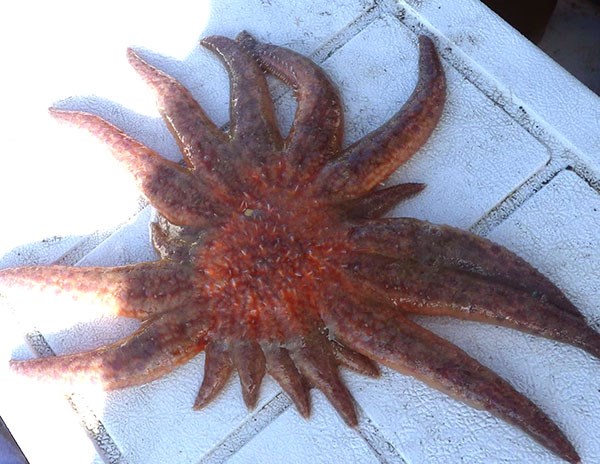When Squamish resident John Buchanan pulled up his prawn trap last week, he was in for a big surprise.
“I thought ‘what the heck, these are supposed to be wiped out in Howe Sound,’” the citizen scientist said.
A large orange sunflower sea star had climbed into the trap and had attached itself to the bait. The trap was set just off Potlatch Creek, approximately 250 feet below the sea’s surface.
Last year, Vancouver Aquarium researchers had found a number of dead and decaying sunflower sea stars in Howe Sound. By the end of September, the echinoderms had all but disappeared in the sound and in Vancouver Harbour.
B.C.’s coast was experiencing a sea star mass mortality event, a phenomenon Vancouver Aquarium scientists coined Sea Star Wasting Syndrome. The epidemic, which seemed to affect a number of starfish, including purple star fish, followed an explosion in the population in previous years, said Jeff Marliave, the aquarium’s vice-president of marine science. The Sea Star Wasting Syndrome event was one of the largest die-offs occurring in the ocean in terms of its geographic range and the scope of the species it hit, he said.
“We are still seeing some healthy populations in our inland seas,” he said. “The babies did not die off.”
Sunflower stars appear to have been hit hardest, aquarium staff noted, with dense aggregations having disappeared in a matter of weeks. The underlying cause of the epidemic is unknown. Scientists are examining whether the wasting syndrome is a pathogen that affects several species in the same way, or if multiple agents are at work.
The mass death of the sea stars is changing the ecosystem, Marliave said. Once a food source for the sunflowers, green sea urchin populations are experiencing a boom. The green sea urchins are wiping out their food source, sea weed, which in turn is eradicating nursing habitat for spot prawns.
“This is called a cascade effect,” Marliave said.
These types of enchinoderms tend to experience huge population waves, he said, noting for more than a decade, he thought sunflower stars were ruining the ecology.
“You take a snapshot at one point in time and think that is normal,” he said. “It was only normal at that point in time.”
Thanks to the observations of citizen scientists, divers and beach walkers, aquarium staff and researchers around the world are able to document such phenomena, Marliave said. That alone has helped supply more eyes in the field than any government agency could ever achieve, he noted.
“We are past the point where people can be confident that there are taxpayer dollars somewhere taking care of every problem,” Marliave said.
Researchers ask that divers and anyone who notices sunflowers and other sea star species report the sightings online at www.vanaqua.org/act/research/sea-stars.
A few of the legs on the sunflower Buchanan found were disintegrating, but new legs seemed to be growing in their place. He threw it back into the water in the hope that the sunflower would survive and procreate.
“It was really exciting to see,” Buchanan said.



